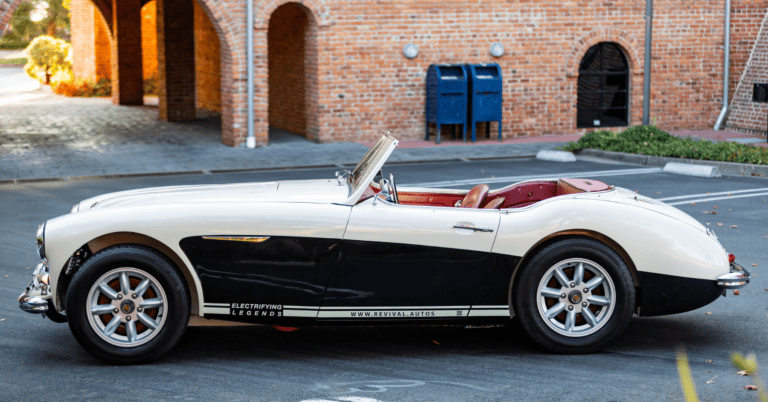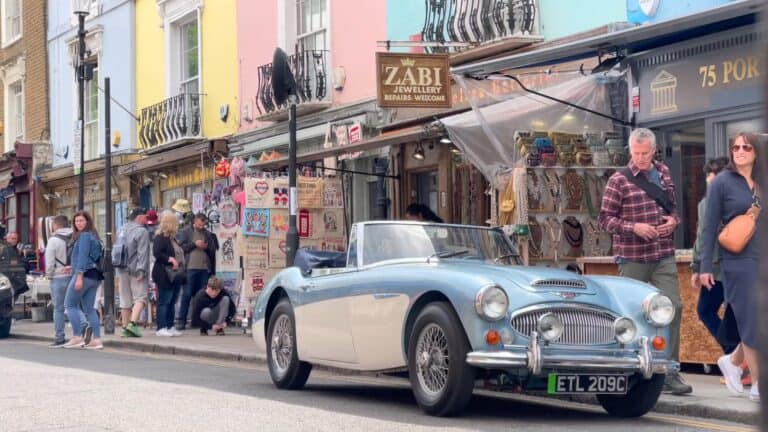In the world of engine swaps and restomods, electrified mods are suddenly gaining craze. While a normal swap will have one ICE (internal combustion engine) replaced by the other, with electrified cars, the ICE is replaced by a set of motors and batteries.
Somehow this idea of future-proofing your car by converting it to electric is growing. The 2021 SEMA saw one such car from Ford called the F 100 Eluminator concept that showcased an old Ford pickup truck fitted with the Ford Mach E power-train.
But it’s not just manufacturers. Many small businesses and garages across the globe are doing that too.
One such business is Revival Autos. A UK-based company that is converting 60’s classic cars into classic EV’s. One of their newer products is the electrified Austin Healey 100. And here is how they do it.
How Revival Auto converts classic cars into electric?
In order to convert a standard old saloon into an EV, you have to make some changes to the body. The challenge is that it needs to be stealthy and must not affect its originality. Revival Auto does so by removing only what’s unnecessary, that is the engine obviously, with the fuel tank, exhaust pipe and everything around it.
With the old grumpy engine out, a new silent electric motor goes in. Then comes the gear assembly and the batteries. To fit in all of these, under-seat spaces and luggage areas are used efficiently. After the installation comes to the wiring, and finally the mapping. The charging dock is retrofitted conveniently in place of the petrol cap and after a final check, conversion is complete.
Another part of the process however is fully restoring the car to the point where it looks as new as when it just came out of the factory. This includes everything from the body paint, lights, bumpers, and tires to your seat cover, dash, and meter. Everything is restored as it was back in the sixties.
After the conversion, the only thing that changed is under the car which can only be spotted after you turn on your keys. Because now all you will hear is a beep and you are ready to go. No more loud engine noise, exhaust smell, shaky transmission, just a silent smooth and linear electric ride.
What’s unique with Revival Autos is that you get an NFT based on the vehicle’s unique chassis number. One can use that NFT to track the history of the car and share its rich heritage with other owners to come.
What are the benefits of converting Classic cars to electric?
Having your car converted into a vintage electric car adds a lot of self-explained benefits. Here are some of them.
- No maintenance cost: The older a car is the more maintenance it needs due to having more worn-out parts. These parts are also rare to find as the company stopped producing them years ago. However, the same issues are not faced with EVs as they have fewer running parts that will last for years. So there is virtually no maintenance cost. With an electrified vintage car the only things you need to take care of are bad weather situations and dirt. Both of which won’t be an issue simply for the fact that you own a rare vintage car that you won’t be parking around unprotected.
- Reduced driving cost: With electrified classic cars there is no fuel cost. You don’t need to keep your oil or coolant filled or worry about transmission fluid. All of which heavily reduced the driving cost of a vehicle.
- Future proof: Over the past 40 years, governments are getting stricter with every emission norm. With major car brands already shifting to EVs only, it won’t be long before combustion engines become a thing of the past. But owning an electric classic car would ensure that you will be riding your old beauty every day and everywhere. Also, it will save you from the guilty conscience of shredding the earth off oxygen.
- Mindful rides: Car rides will also become a lot more pleasurable thanks to a silent smooth powertrain. You wouldn’t have to worry about pushing the car too hard or getting distracted by loud exhaust noise. Your classic EV would also not suddenly stop in the middle of the road with oil all over it. But it will stop if you run out of battery, so be mindful.
- No taxes: With Zero emission vehicles there are no taxes attached. You don’t have to pay road taxes, tariffs on fuel or emission taxes as you do with old vintage cars.
Is converting classic cars to EVs expensive? How much does an electric classic car cost?
Owning a classic car is expensive simply because it is a vintage car that needs special care. That does not change even after you convert your car from ICE to EV. What changes are additional charges like fuel costs, and maintenance costs that are permanently reduced. But that does come at a price.
While EV technology has become a lot more cheaper and accessible, aftermarket OEM products still cost a premium. That ultimately increases the price of converting classic cars to EVs. Normally, converting to a classic electric sports car in London would run around £25,000 to £30,000. Yes, you can buy a brand new car with that money, but in a way you are getting a 60-year-old new car, that will last the same time as the brand new one.
Also, using OEM parts does ensure that you are getting high-quality products that would last you for years. Not to mention the additional benefits that come along with it. Like having a more powerful and reliable powertrain that costs very little money to run.
All in all, converting to an electric classic car might sound like a liability, but in reality, it is a one-time investment that will ensure your vintage car’s sustainability. With Revival Auto, you can give your classic a new life, one that you both will enjoy.





